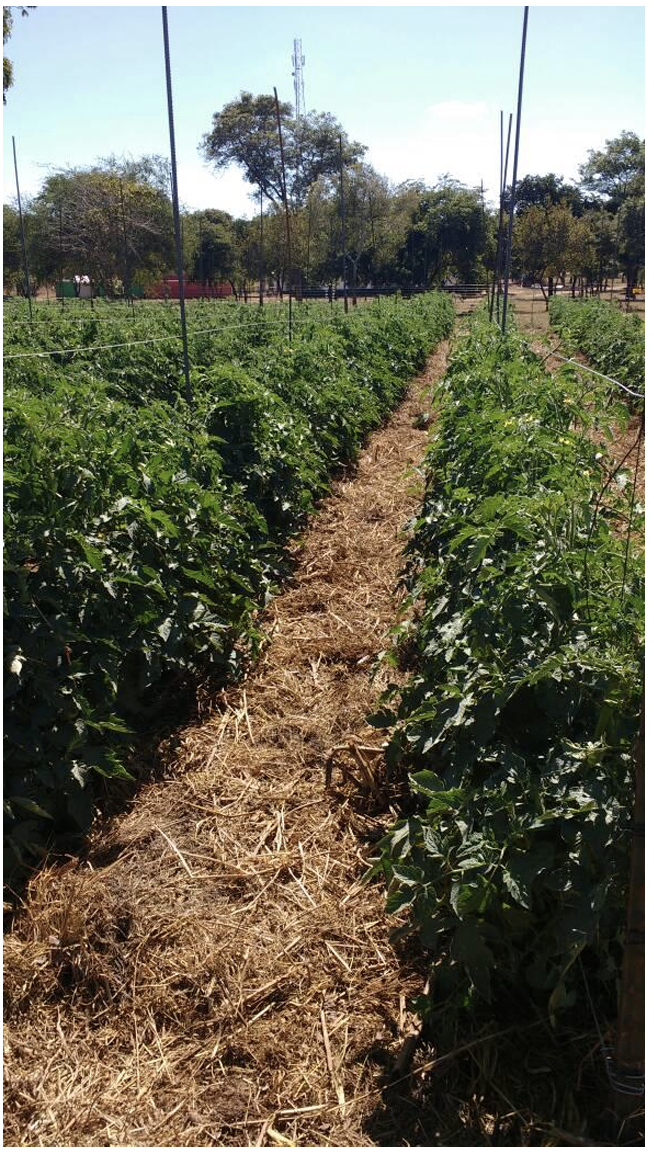6.1.6 Tomato – Compost/Manure Technique
Tomatoes are the most popular of all the vegetables and are full of healthy ingredients including vitamins A, C and E as well as anti-oxidants. However tomatoes are also one of the most difficult to grow successfully requiring excellent management; deep, fertile well drained soils; and excellent pest and disease control which is not common amongst poor communities. Tomatoes should therefore be avoided until sufficient experience has been gained and the soil has had good care and healthy compost inputs for a few seasons. Tomatoes prefer a spring to early summer planting time with optimal growing temperatures of 20-27°C.
Layout
Field scale growers mostly grow determinate varieties at 60cm between plants and 150cm between rows for better light penetration and ease of movement, whereas small scale or home gardeners can grow them at 60 by 75cm intervals.
Indeterminate varieties climb a lot more and also set fruit over a much longer timeframe, so plant these at 60cm between plants and 150cm between rows.
Tomato fruit is very heavy and the plants are prone to lodging, therefore it is advisable to build a trellis network on the row lines for the plants to gain support.
Placing 60cm Measuring Rope
Place a 60cm measuring rope from one 75cm permanent peg to its adjoining 75cm permanent peg on the opposite side. Make sure the rope is taut and straight by lifting and dropping it.
Remove God’s Blanket
Move God’s Blanket 30cm downslope from each planting station, to expose the soil.
Soil Fracturing
Give your tomatoes a good chance of success by fracturing each 75cm row line to 30cm deep.
Digging Planting Stations
The wide plant spacing make them best suited for inputs placed directly into planting stations rather than surface composting. Dig a planting station 15cm deep at each 60cm interval, moving the soil downslope of the measuring rope, taking care to neatly heap the soil for reuse later. Planting stations should be 12cm wide, 15cm long and 15cm deep. For home grown determinate tomato varieties repeat planting stations every 75cm row, whereas with field scale and all indeterminate tomato varieties repeat every alternate row at 150cm.
Correcting Acidic Soils
To correct acidic soils and allow for readily available plant nutrients apply 1 tablespoon of woodash/bonemeal or 1 teaspoon of lime, in each planting station.
Compost/Manure
It is preferable to apply 500ml of compost in each planting station. If you don’t have compost, then you should use older, more mature manure otherwise the tomatoes will produce too many leaves and less fruit. Cover all the inputs with soil from the downslope heap until the soil surface is level again. Replace the 2.5cm thick blanket on top of the planting stations.
Planting Seedlings
Once seedlings are at about 10-12cm tall they are ready for transplanting. Twist the dibble stick through the blanket and press it into the centre of each planting station, to the required depth. You must ensure the seedling roots are not bent into a J shape which will adversely affect the plant’s growth, so make sure the dibble stick hole depth is sufficient, but not too deep either. If the hole is too deep, it will cause there to be an air space under the roots which is also not desirable. To ensure you don’t have that, hold the Tomato seedling in place and press with the dibble stick or your fingers at an angle, pressing the soil gently around the seedling roots. This ensures the seedling roots have no bend and ensures that there are no airspaces around the root zone.
Pest Control
Tomatoes are susceptible to many pests and diseases but your first line of defence is to keep the plants stress free by having healthy soils, thick mulch cover and an excellent supply of nutrients. Any organic pest management control must first focus on prevention rather than cure.
All the solanaceous plants, (Tomatoes, Eggplants, Peppers and Potatoes) are susceptible to similar pests and diseases, so it is critical to have a 2 year break in your rotation planning with these crops.
There are countless organic pest and disease control options available from insecticidal repellent oils, such as Neem oil, to diluted milk to keep powdery mildew under control, to mention just a few (See Chapter 5).
Observe your plants regularly and if diseased plants have been identified it is often the best option to simply remove those plants and dispose of them far away from the garden.


